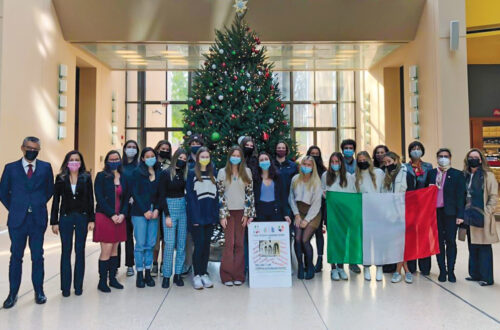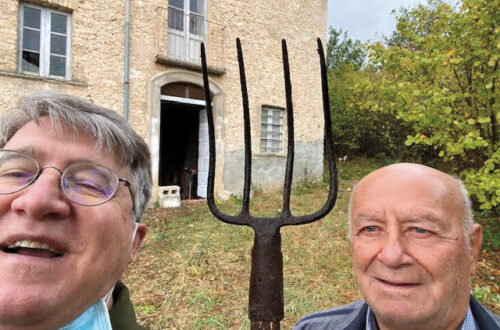-
U.S., Italian High Schools Launch Twinning Project
By Ray LaVerghetta
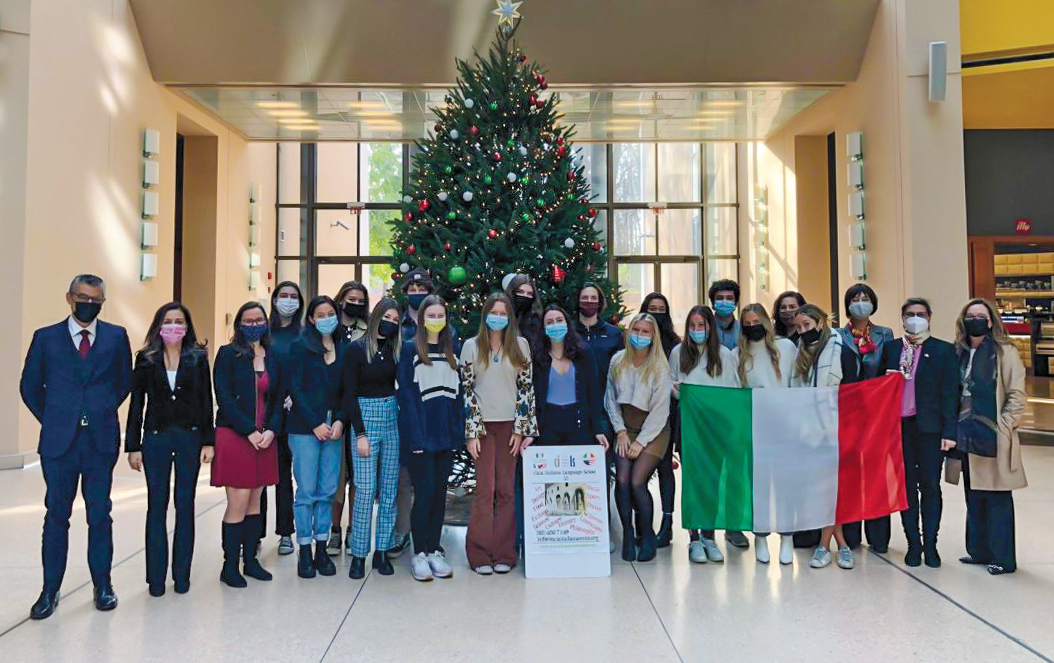
Students and staff from Annapolis met with officials at the Italian embassy for a virtual meeting with their “twin” school in Italy. At left, Domenico Bellantone, First Counselor of the embassy and Maria Fusco, head of the Embassy Education Office pose with Annapolis High School Italian teacher Maria LaVerghetta (3rd from left) and participants from the school.
Credit: Courtesy of the Embassy of ItalyOn December 9, 2021, the Italian Embassy in Washington, D.C., hosted a meeting as part of an exciting twinning project between two high schools — one in Maryland and one in Italy. The project is part of the Embassy’s goal of promoting the study of the Italian language among U.S. students and deepening the cultural ties between young people in the U.S. and Italy.
The meeting, which took place in the Embassy auditorium, brought together students from the two participating high schools: Annapolis High School in Annapolis, Maryland and the Parentucelli/Arzelà high school in the city of Sarzana, which is located in the province of La Spezia in Italy’s Liguria region. The Italian students participated in the meeting virtually while the students from Annapolis High School were present in person.
The twinning project aims to build a bridge connecting the cities of Washington, D.C., Annapolis, Maryland, and Sarzana, Liguria. In particular, it aims to promote the study of Italian in the Washington metropolitan area and the study of English in Sarzana. Students will increase the knowledge of their target language by studying each country’s history, culture, art and music. They will also have the opportunity to take part in language and cultural exchanges, during which they will be able to stay with a host family. In this way, they will both enhance their Italian/English language skills and act as ambassadors by spreading knowledge of their native language and culture. Key partners in the project include the promotional body of the Casa Italiana Language School, the city of Sarzana, and the Italian Ministry of Foreign Affairs and International Cooperation (through its generous funding).
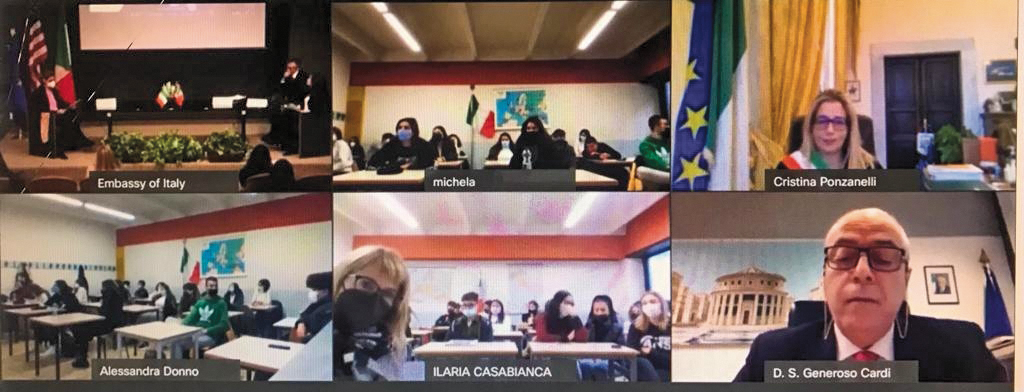
This screen shot shows the virtual participation of the Mayor of Sarzana, Cristina Ponzanelli, and Principal Generoso Cardinale of Parentucelli/Arzelà high school, as well as students from English language classes.
Credit: Maria LaVerghettaDr. Paola Corneo, Director of the Casa Italiana Language School, opened the meeting by thanking the principals and teachers of the two schools for their hard work in setting up the project. In the case of Annapolis High School, the Italian teacher is AMHS member Maria LaVerghetta, who accompanied the Annapolis High students to the meeting. Representing the Embassy were the First Counselor Domenico Bellantone and the head of the Education Office Maria Fusco. Counselor Bellantone addressed the group in attendance, pointing out to the students that this project would likely be their introduction to the world of international relations and that they would be able to increase their mutual understanding of each other’s culture while improving their speaking and listening skills. The Mayor of Sarzana, Cristina Ponzanelli, also addressed the group. She underscored her city’s full support for the project and conveyed the greetings of the Governor of the region of Liguria, Giovanni Toti.
Students at both Annapolis High School and Parentucelli/Arzelà high school are excited about the opportunities that lie ahead. These opportunities are a good example of what can be accomplished in the teaching of foreign languages and cultures when teachers, schools, municipal and regional authorities all work together.
March/April 2022
-
Henry Mancini: Legendary Composer of Music for Films and TV
By Joseph “Sonny” Scafetta, Jr.

Henry Mancini c. 1960.
Credit: henrymancini.comFrom the cool, mischievous opening bars of the “Pink Panther” to the wistful strains of “Moon River,” to the driving beat of the theme from Peter Gunn, Henry Mancini gave the world some of the most memorable music ever written for films and television. This musical genius had roots in both Abruzzo and Molise.
Enrico Nicola Mancini was born in the Little Italy section of Cleveland, Ohio, on April 16, 1924. His father Quintiliano, an amateur musician, had emigrated from the community of Scanno (population 1,883 in the 2015 Census) in the province of L’Aquila in the region of Abruzzo in 1910 at age 17. His mother, Anna Pece, had emigrated as an infant with her family from the community of Forlì del Sannio in the province of Isernia in the region of Molise.
When Enrico was a toddler, the family moved to West Aliquippa so that his father could work in the nearby Jones & Laughlin Steel Mill in Pittsburgh, Pennsylvania. Enrico started studying the piccolo and flute at age eight. While still in high school, he began studying music under Max Adkins, the orchestra conductor for the Stanley Theater in Pittsburgh. After graduating from Aliquippa High School in June 1942, he changed his first name to Henry and attended the School of Music at Carnegie Institute of Technology (now Carnegie Mellon University) in Pittsburgh. In January 1943, he transferred to the Juilliard School of Music in New York City. After classes ended in June 1943, he enlisted in the U.S. Army Air Forces. While in basic training in Atlantic City, New Jersey, he met several musicians being recruited by band leader, Glenn Miller, who recommended to Henry’s superiors that he be assigned to the 28th Air Force Band. After Miller’s death in an airplane crash in December 1944, Henry was re-assigned to the 1306th Engineers Brigade fighting in France. Before World War II ended in Europe in May 1945, he helped to liberate the Mauthausen-Gusen concentration camp in Austria. After three years of service, he was honorably discharged in June 1946.
Henry then went to work as a pianist and arranger for the new Glenn Miller Orchestra led by Tex Beneke. After a year, he left the orchestra and moved to Hollywood. In September 1947 at age 23, he married Virginia “Ginny” O’Connor, a singer with the new Glenn Miller Orchestra. They had three children. With his bride’s encouragement, he began private music studies with composer Mario Castelnuovo-Tedesco. He also began writing music for radio programs and composing arrangements for night club acts. To ensure a steadier income for his growing family, Henry joined the music department of Universal-International Studios in 1952. There he began composing music and songs for films. His score for The Glenn Miller Story won him his first Academy Award nomination in 1954. The last score which he wrote for the studio was for the film Touch of Evil that was released in early 1958. Overall, he composed music and songs for about 100 films until the studio disbanded its music department in mid-1958.
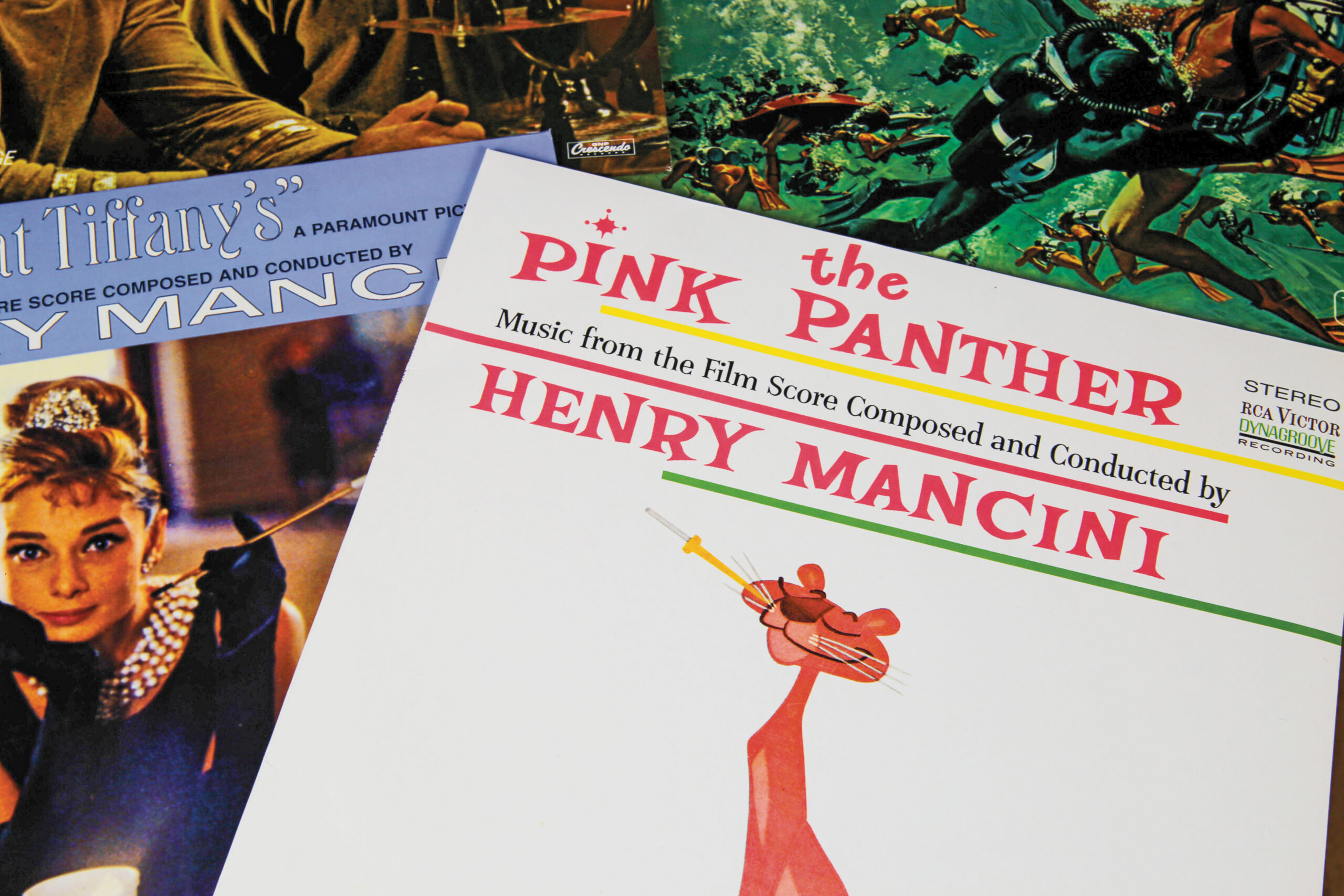
Mancini’s film scores sold in the millions.
Credit: Ralf Liebhold/Alamy stock photoBlake Edwards, a producer, asked the freelancing Mancini to wrote a score for a new TV detective series to be called Peter Gunn. RCA-Victor then released an album, Music from Peter Gunn. Before the end of 1958, it won Mancini two Grammy Awards for best album and best arrangement. In 1959, Edwards produced another TV detective series called Mr. Lucky. The album, Music from Mr. Lucky, earned Mancini two more Grammys for best arrangement and best orchestra performance in 1960. Mancini also won a third Grammy that year for another album entitled The Blues and the Beat. Edwards’s next film was Breakfast at Tiffany’s and Mancini’s music garnered five more Grammys and his first two Oscars, one for best original score and the other for the best song which was “Moon River.” In 1962, Mancini provided music for the films Experiment in Terror and Hatari! which had the theme song “Baby Elephant Walk” that won him another Grammy. That year he also published a book entitled Sounds and Scores: A Practical Guide to Professional Orchestration. Before the year was up, his collaboration with Edwards led to the theme song for Days of Wine and Roses winning Mancini another Oscar for best song. In 1963, Mancini’s theme song for the romantic mystery movie Charade, directed by Stanley Donen, won him another Oscar nomination for best song. When Edwards started The Pink Panther comedy movie series in 1964, Mancini composed the music. Other popular films for which Mancini wrote the music were Dear Heart directed by Delbert Mann in 1964, The Great Race directed by Donen in 1965 and Two for the Road directed by Donen in 1967. Mancini’s arrangement and recording of the “Love Theme from Romeo and Juliet” was a number one hit single on the Hot 100 for two weeks in June 1969.
Mancini’s fourth and last Oscar was won for best score with the music for Victor/Victoria directed by Edwards in 1982. Mancini also scored many TV movies, such as The Thorn Birds in 1983. In 1989, he published his autobiography Did They Mention the Music? Also in 1989, he received the Golden Plate Award from the American Academy of Achievement. Mancini died of pancreatic cancer in Los Angeles on June 14, 1994, two months after his 70th birthday.
Overall, Mancini was nominated for 72 Grammys and won 20. He was also nominated for 18 Academy Awards and won four. In addition, he was nominated for two Emmys and he won one Golden Globe. Mancini recorded 90 albums, eight of which were certified gold by the Recording Industry Association of America. He was also a concert performer, sometimes conducting about 50 engagements per year, resulting in about 600 symphony performances during his lifetime.
In 2001, the American Society of Composers, Authors and Publishers (ASCAP) Foundation established the Henry Mancini Music Scholarship which has been awarded annually. On April 13, 2004, the U.S. Postal Service honored him with a 37-cent commemorative stamp which shows him conducting in front of a list of some of his most popular movie and TV themes while the Pink Panther in the lower left corner points to Mancini.
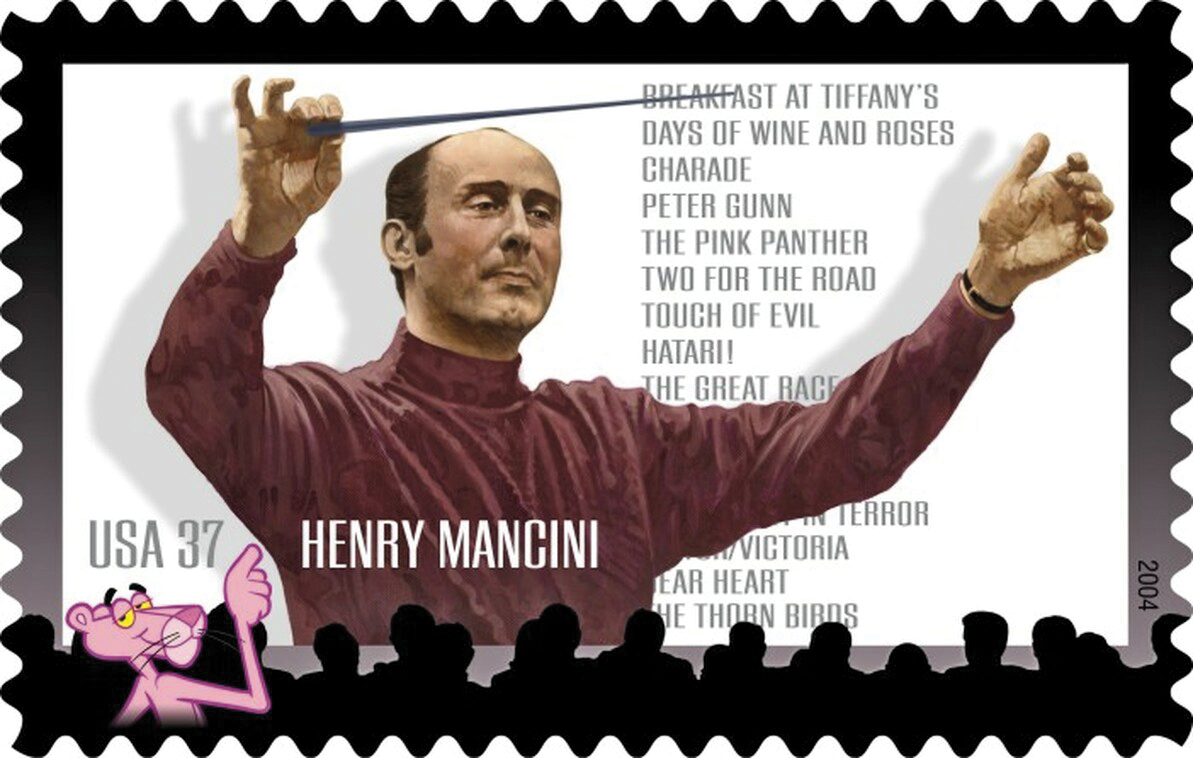
The US Postal Service issued this stamp in Mancini’s honor in 2004. Note his pink friend in the lower left.
Credit: USPSSources, all accessed June 13, 2021: American National Biography Series, vol. 14 at pgs. 396-397 (Oxford University Press 1999)
en.wikipedia.org/wiki/Henry_Mancini
postalmuseum.si.edu/object/npm_2004.2018.37
en.wikipedia.org/wiki/Scanno,_Abruzzo
en.wikipedia.org/wiki/Forlì_del_SannioMarch/April 2022
-
Campomarino

By Nancy DeSanti
Province of Campobasso, Region of Molise
The beautiful town of Campomarino is located in the province of Campobasso. It has approximately 8,057 inhabitants known as Campomarinesi. The Campomarino comune includes the seaside tourist resort of Campomarino Lido, just above sea level, and the village of Campomarino itself, located on a hill behind it.
Among groves of olive trees and near a wide, beautiful beach, the town, which is on the borderline with the province of Foggia in Puglia, enjoys a spectacular view of the Biferno valley, as far as the Tremiti Islands.
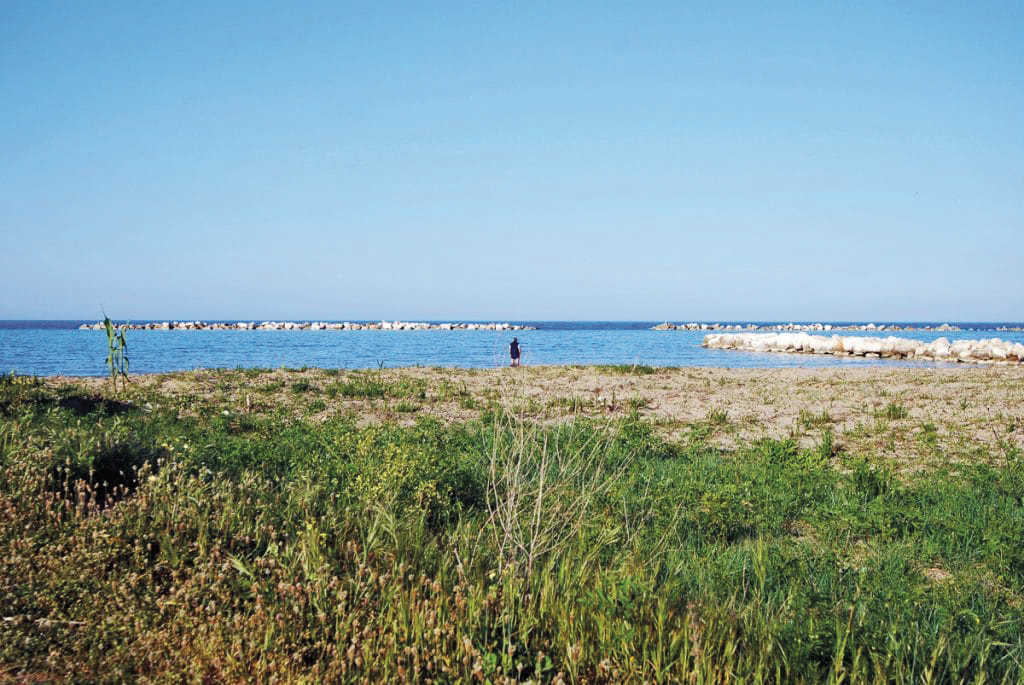
The mouth of the Biferno River at Campomarino.
Credit: molisecoast.comThe very ancient origin of the town is indicated by the bronze items from the 12th century B.C. found in the area of Defensola, which was probably the site of a Roman colony called Cliternia. It was under many feudal lords, with the last being the Di Sangro family in the 16th century
Campomarino’s enchanting landscape can be admired from the terrace near the ancient village and the church of Santa Maria a Mare. Until a few decades ago, the town was populated by people of Albanian origin, who were known as very good farmers. Their language is still spoken there.
Located near the town, Campomarino Lido is now a favorite place for summer seaside tourism. With its tourist port and its beaches surrounded by pine forests that reach to the mouth of the Biferno River, it is now considered a beautiful recreational destination.
Today, Campomarino is also a town which produces good wine, especially the variety known as Tintilia.
Campomarino is famous for its tratturo, the pastoral route for the migration of sheep between summer and winter pastures. The tratturo from L’Aquila to Foggia, 244 kilometers long, is the most important of the five Regi (Royal) Tratturi, which is why it is also called Tratturo Magno. The section crossing Campomarino is the last one in Molise. The tratturi are considered an important monument of the social and economic history between the Abruzzese-Molisano Apennines and Tavoliere delle Puglie, preserved for seven centuries.
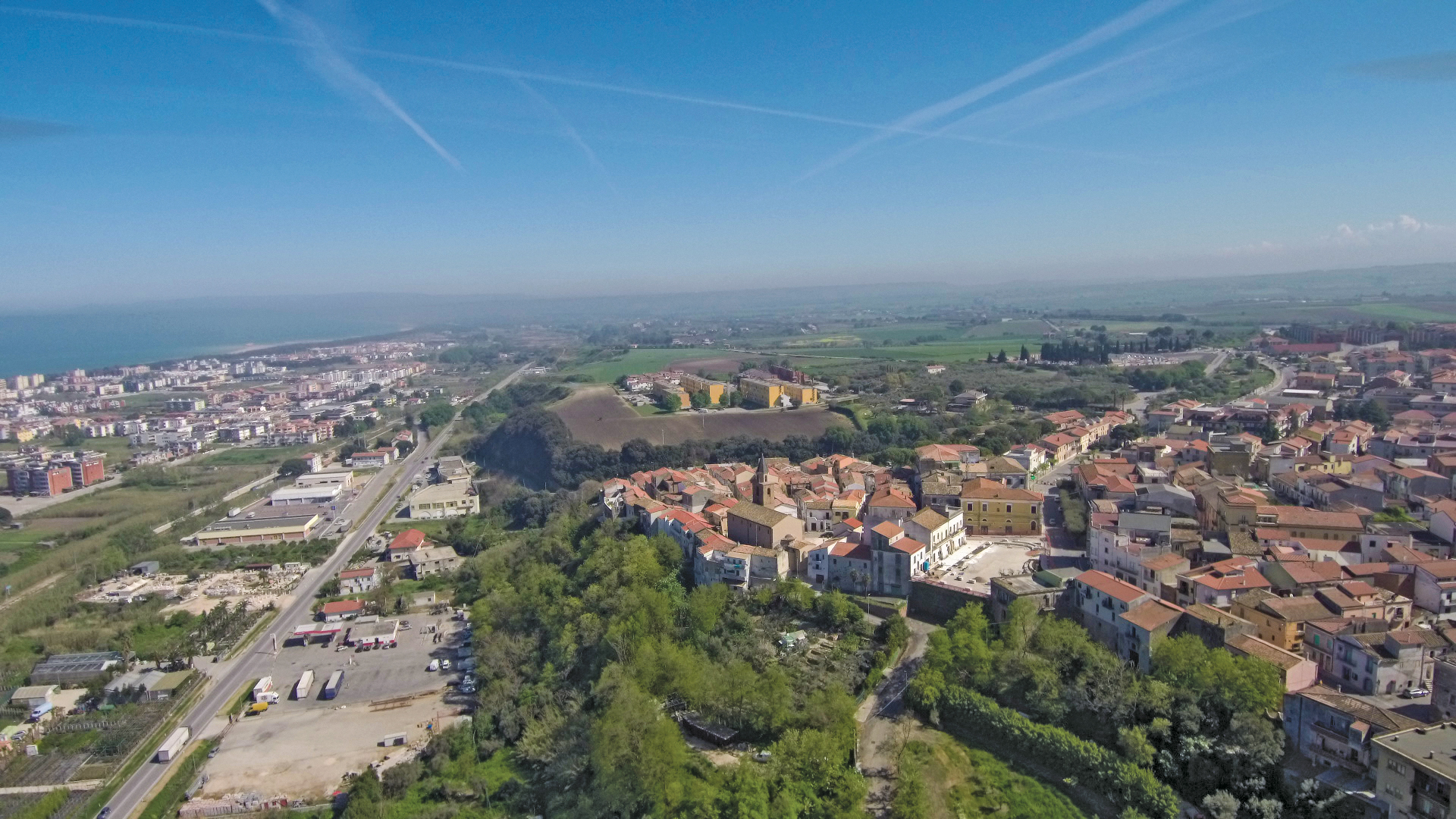
A bird’s eye view of Campomarino.
Credit: WikipediaThe Tratturo Magno brought enormous herds from the mountains of Gran Sasso, Sirente and Majella to the wide pastures of the Tavoliere, often touching the Adriatic coast. This is the only tratturo where sheep and shepherds reached the sea. The route of the Tratturo Magno starts at the Church of Santa Maria di Collemaggio in L’Aquila, enters Molise, goes to the Fortore River and reaches the Tavoliere, where it ends in Foggia, meeting the tratturo from Celano.
Still today, along the route, you can see several countryside churches or chiese tratturali meant for the rest and comfort of shepherds, like the church of San Paolo di Peltuinum and Santa Maria dei Cintorelli, where the Tratturo Centurelle-Montesecco starts. The Tratturo L’Aquila-Foggia has been recently studied by the Abruzzese Associazione Tracturo 3000, which since 1997 has been organizing trekking routes divided into nine stages along the pathway.
What to See
- The 12th century church of Santa Maria a Mare with beautiful columns, an ancient crypt, and frescoes of St. Demetrius fighting the Saracens and of St. Nicholas.
Important Dates
- July 24 — Feast of St. Catherine, the patron saint
Italiano

Tradotto da Ennio Di Tullio
Provincia di Campobasso, Regione Molise
Il bellissimo paese di Campomarino si trova in provincia di Campobasso. Conta circa 8.057 abitanti conosciuti come Campomarinesi. Il comune di Campomarino comprende la località turistica balneare di Campomarino Lido, poco sopra il livello del mare, e lo stesso paese di Campomarino, posto su una collina alle sue spalle.
Tra uliveti e in prossimità di un’ampia e bella spiaggia, il paese, che si trova al confine con la provincia di Foggia in Puglia, gode di una vista spettacolare sulla valle del Biferno, fino alle Isole Tremiti.
L’antichissima origine del paese è indicata da oggetti in bronzo del XII secolo a.C. rinvenuto nella zona di Defensola, che probabilmente era sede di una colonia romana denominata Cliternia. Fu sotto molti feudatari, ultimo dei quali la famiglia Di Sangro nel 16° secolo.
L’incantevole paesaggio di Campomarino si può ammirare dalla terrazza vicino al borgo antico e alla chiesa di Santa Maria a mare. Fino a pochi decenni fa il paese era popolato da persone di origine albanese, conosciute come ottimi contadini. La loro lingua è ancora parlata lì.
Situato nei pressi del centro abitato, Campomarino Lido è oggi una delle mete preferite del turismo balneare estivo. Con il suo porto turistico e le sue spiagge circondate da pinete che arrivano fino alla foce del fiume Biferno, è oggi considerata una bella meta di svago.
Oggi Campomarino è anche un paese che produce del buon vino, in particolare dal vitigno noto come Tintilia.
Campomarino è famosa per il suo tratturo, la via pastorale per la migrazione dei greggi tra i pascoli estivi e invernali. Il tratturo da L’Aquila a Foggia, lungo 244 chilometri, è il più importante dei cinque Tratturi Regi, per questo è anche chiamato Tratturo Magno. Il tratto che attraversa Campomarino è l’ultimo in Molise. I tratturi sono considerati un importante monumento della storia sociale ed economica tra l’Appennino Abruzzese-Molisano e il Tavoliere delle Puglie, conservato per sette secoli.
Il Tratturo Magno portava enormi mandrie dai monti del Gran Sasso, Sirente e Majella agli ampi pascoli del Tavoliere, toccando spesso la costa adriatica. Questo è l’unico tratturo dove pecore e pastori arrivavano al mare. Il percorso del Tratturo Magno inizia presso la Chiesa di Santa Maria di Collemaggio a L’Aquila, entra in Molise, va al fiume Fortore e raggiunge il Tavoliere, dove termina a Foggia, incontrando il tratturo di Celano.
Ancora oggi, lungo il percorso, si possono vedere diverse chiese campestri o chiese tratturali destinate al riposo e al conforto dei pastori, come la chiesa di San Paolo di Peltuinum e di Santa Maria dei Cintorelli, dove ha inizio il Tratturo Centurelle-Montesecco. Il Tratturo L’Aquila-Foggia è stato recentemente studiato dall’Associazione Abruzzese Tracturo 3000, che dal 1997 organizza percorsi di trekking suddivisi in nove tappe lungo il percorso.
Le attrazioni del luogo:
- La chiesa di Santa Maria a Mare del XII secolo con belle colonne, un’antica cripta e affreschi raffiguranti San Demetrio in lotta contro i Saraceni e San Nicola.
Date da ricordare:
- 24 luglio — Festa di Santa Caterina, patrona
March/April 2022
-
Bugnara

By Nancy DeSanti
Province of L’Aquila, Region of Abruzzo
The beautiful town of Bugnara is located in the province of L’Aquila, It has approximately 1,112 inhabitants, known as Bugnaresi. In 2007, it was designated as one of the most beautiful villages in Italy (i borghi più belli d’Italia), by an association that lists small Italian towns of strong artistic and historical interest.
This picturesque medieval town lies at the bottom of Colle Rotondo, along the right bank of the Sagittario River. Coming from the direction of the beautiful gorge of the river, Bugnara is the first village in the conch-shaped Peligna valley. It is on the ancient Samnite road which leads to Scanno and Villetta Barrea. The town is between local hub Sulmona and the tourist destination of Scanno. Buses run from Scanno, past Bugnara, and on to Sulmona and Rome. Just outside the village, remains of megalithic walls can still be seen.
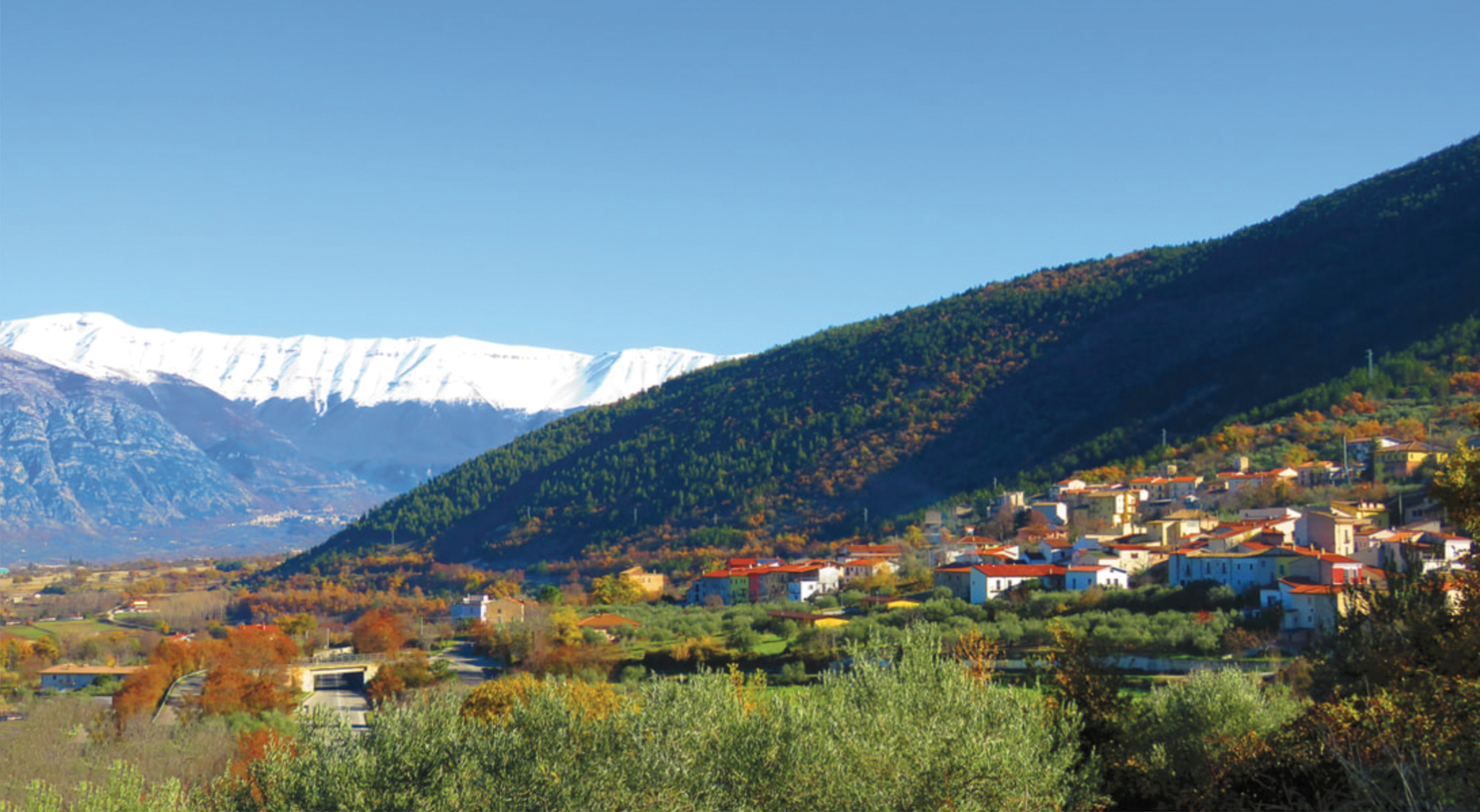
A view of Bugnara with the Gran Sasso d’Italia in the background.
Credit: italy review.comBugnara is near the Gran Sasso d’Italia, the largest Italian mountains south of the Alps, and also near Roccaraso, a popular ski resort.
In 1706, 1933 and 1984, Bugnara was hit by major earthquakes. In particular, the 1984 earthquake severely damaged the village, and the historic churches of Bugnara were inaccessible for a long time afterwards. Back in 1891, a train line and station were built in Bugnara. But the tall rail bridge over the Sagittario was blown up during World War II, as it was seen as a link to Rome. The bridge was later reconstructed. In 1974, an important historic and artistic artifact was rediscovered — the 13th century sculpture of the Virgin and Child known as the Madonna delle Concanelle from the Madonna della Neve church. It is now preserved in the National Museum of Abruzzo in L’Aquila.
The earliest documented evidence of Bugnara dates back to the 6th century, although archaeological finds indicate that the settlement was inhabited much earlier. In the year 1000 A.D., the Madonna della Neve Church was built. In 1079, the town became the fiefdom of Simone di Sangro. The village grew in the 15th century and successively belonged to the Sangros, Maricondas and finally the Mormile family.
The town’s layout takes the triangular format typical of the medieval period. The houses, built entirely of stone, were constructed one against the other. Narrow streets climb toward the top of the village, where the Castello Ducale Medievale sits. Around the village are tratturi — pastoral routes for the migration of sheep between summer and winter pastures.
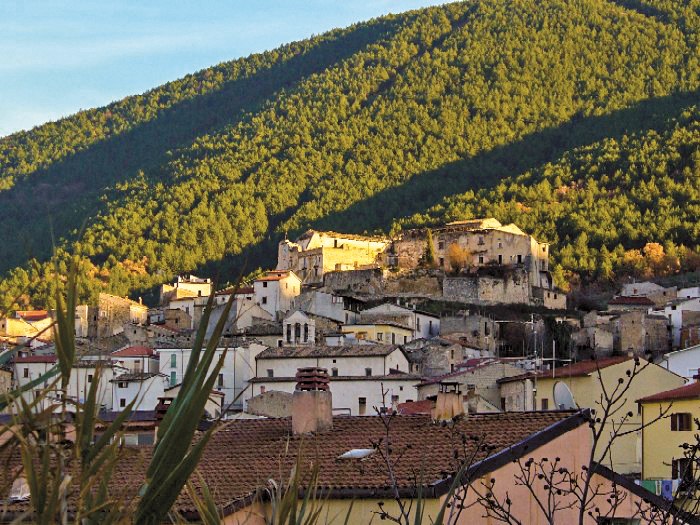
Another view of Bugnara.
Credit: WikipediaThe town, like many others, strives to maintain its traditions, including the “Romantica and the International Florists’ Festival,” also called “Hearts under the stars.” It’s an all-night celebration with various specialty drink and food stalls, dancing, live music, fashion shows, floral displays, theatrical events and photo exhibitions. During the first weekend in August, florists from all the world compete to decorate the historic town center of Bugnara.
Another event is the Sagra del Formaggio Pecorino di Bugnara. It is dedicated to Bugnara’s most archetypal product — pecorino cheese, a hard, full-flavored, sheep’s milk cheese. Bugnara pecorino originates in rich mountain pastures where specific herbs grow.
Yet another popular event is the Fiera del Gusto e della Solidarietà (“Christmas Market of Flavors and Solidarity”). The aim of this pre-Christmas event is to collect money for a charity which is chosen each year. Every organization, school and other group in Bugnara arranges a market stall with artisan products or foods.
For a related article on AMHS member Willy Meaux’s adventures in buying a farmhouse in Bugnara, his family’s ancestral land, see “AMHS Member Willy Meaux Returns to His Roots in Abruzzo.”
What to See
- Madonna della Neve Church, also known as the Madonna delle Concanelle, which has three naves, supported by gothic arches.
- Santissimo Rosario Church which sits in the piazza of the same name and was built between the 16th and 17th centuries. The highlight is the majestic carved altar, which with its many colors and sense of motion, is a prime example of the Abruzzo baroque style.
- Madonna degli Angeli Church, a small 14-century church located near the Madonna della Neve Church, which contains a frescoed triptych of the Madonna.
- Ducal palace or Palazzo Ducale di Sangro, also known as Rocca dello Scorpione and Castello Ducale Medievale. The large castle at the summit of the village was built in the 12th century by the di Sangro family, who inhabited it until 1500 A.D. It is walled, with two towers, and it offered protection to the people of Bugnara when they were under siege.
Important Dates
- August 4-5 — Feast of Madonna della Neve
- September 4-5 — Feast of St. Magno and St. Vittorino
Italiano

Tradotto da Ennio Di Tullio
Provincia di L’Aquila, Regione Abruzzo
Il bellissimo comune di Bugnara si trova in provincia di L’Aquila, conta circa 1.112 abitanti, noti come Bugnaresi. Nel 2007 è stato designato come uno dei Borghi più belli d’Italia, da un’associazione che elenca i piccoli centri italiani di forte interesse artistico e storico.
Questo pittoresco borgo medievale sorge ai piedi del Colle Rotondo, lungo la sponda destra del fiume Sagittario. Provenendo dalla direzione della bellissima gola del fiume Sagittario, Bugnara è il primo paese della valle Peligna, la quale è a forma di conchiglia. Si trova sull’antica strada sannitica che porta a Scanno e a Villetta Barrea. Il paese è compreso tra Sulmona e la località turistica di Scanno. Gli autobus partono da Scanno, vanno oltre Bugnara, e proseguono per Sulmona e Roma. Ancora visibili appena fuori dal paese sono resti di mura megalitiche.
Bugnara è vicino al Gran Sasso d’Italia, la più grande montagna italiana a sud delle Alpi, e anche vicino a Roccaraso, una rinomata località sciistica.
Nel 1706, 1933 e 1984 Bugnara fu colpita da forti terremoti. In particolare il terremoto del 1984 danneggiò il paese e le chiese storiche di Bugnara rimasero per lungo tempo inaccessibili. Già nel 1891 a Bugnara furono costruite una linea ferroviaria e una stazione. Ma l’alto ponte ferroviario sul Sagittario fu fatto saltare in aria durante la seconda guerra mondiale poiché era considerato un collegamento con Roma. Il ponte è stato successivamente ricostruito. Nel 1974 è stato riscoperto un importante manufatto storico e artistico: la scultura duecentesca della Madonna col Bambino detta Madonna delle Concanelle proveniente dalla chiesa della Madonna della Neve. Attualmente è conservato al Museo Nazionale d’Abruzzo a L’Aquila.
Le prime testimonianze documentate di Bugnara risalgono al VI secolo, anche se reperti archeologici indicano che l’insediamento fu abitato molto prima. Nell’anno 1000 d.C. fu edificata la Chiesa della Madonna della Neve. Nel 1079 il paese divenne feudo di Simone di Sangro. Il paese crebbe nel XV secolo e successivamente appartenne ai Sangro, ai Mariconda ed infine ai Mormile.
La pianta del paese assume la forma triangolare tipica del periodo medievale. Le case, costruite interamente in pietra, erano addossate l’una contro l’altra. Stradine strette salgono verso la sommità del paese, dove sorge il Castello Ducale Medievale. Intorno al paese si trovano i tratturi, percorsi pastorali per la migrazione delle pecore tra i pascoli estivi e invernali.
Il paese, come tanti altri, si sforza di mantenere inalterate le sue tradizioni, tra cui la “Romantica e la Festa Internazionale dei Fioristi”, detta anche “Cuori sotto le stelle”. È una festa che dura tutta la notte con varie bancarelle di bevande e cibo speciali, balli, musica dal vivo, sfilate di moda, mostre floreali, eventi teatrali e mostre fotografiche. Nel primo weekend di agosto fioristi da tutto il mondo si sfidano per decorare il centro storico di Bugnara.
Altro appuntamento è la Sagra del Formaggio Pecorino di Bugnara. È dedicata al prodotto più archetipico di Bugnara: il pecorino, un formaggio di latte di pecora a pasta dura e dal sapore pieno. Il pecorino Bugnara ha origine in ricchi alpeggi dove crescono erbe specifiche. Altro appuntamento popolare è la Fiera del Gusto e della Solidarietà (“Mercatino di Natale dei Sapori e della Solidarietà”). Lo scopo di questo evento pre-natalizio è raccogliere fondi per un ente di beneficenza che viene scelto ogni anno. Ogni organizzazione, scuola e altro gruppo a Bugnara organizza una bancarella del mercato con prodotti o cibi artigianali.
Vedere “AMHS Member Willy Meaux Returns to His Roots in Abruzzo“ per un articolo sulle avventure di Willy Meaux, membro dell’AMHS, nell’acquisto di una fattoria a Bugnara, terra ancestrale della sua famiglia.
Le attrazioni del luogo:
- Chiesa della Madonna della Neve, detta anche Madonna delle Concanelle, a tre navate, sorrette da archi gotici.
- Chiesa del Santissimo Rosario che sorge nell’omonima piazza e fu edificata tra il XVI e il XVII secolo. L’attrazione principale è il maestoso altare scolpito, che con i suoi numerosi colori e il senso del movimento, è un ottimo esempio dello stile barocco abruzzese.
- Chiesa della Madonna degli Angeli, chiesetta del XIV secolo situata nei pressi della Chiesa della Madonna della Neve, che contiene un trittico affrescato della Madonna.
- Palazzo Ducale o Palazzo Ducale di Sangro, detto anche Rocca dello Scorpione e Castello Ducale Medievale. Il grande castello alla sommità del paese fu edificato nel XII secolo dalla famiglia di Sangro, che lo abitò fino al 1500 d.C. È murato, con due torri, e offriva protezione ai Bugnaresi quando erano assediati.
Date da ricordare:
- 4-5 agosto — Festa della Madonna della Neve
- 4-5 settembre — Festa di S. Magno e S. Vittorino
Sources: en.wikipedia.org/wiki/Bugnara
www.italyheritage.com/regions/abruzzo/laquila/bugnara.htm
viaggiart.com/en/bugnara
www.italytravellerguide.com/paesi/bugnara-1833March/April 2022
-
AMHS Membership
By Lynn Sorbara, 2nd Vice President-Membership
New Members Welcome to our New Members: Christopher Anthony Di Paolo; Bruce Anthony Evans; Gary Evans; Macarena Fernandez; Joan & Roger Galles; and Bernard Mckibben. Birthdays Compleanni a Marzo
Eileen Parise Del Monaco, March 1; Robert D’Onofrio and Greg Bernabei, March 2; Maria Fresco, March 3; Salvatore DiPilla, March 8; Charles Philip D’Adamo, March 9; Maria Antoinette Kellaher and Sam Yothers, March 12; Mary Petrino, March 14; David Scalzitti, March 19; Pam Lupo, March 21; Thomas Ronan and Benjamin O’Hara, March 24; Mary Katherine Theis, March 25; Lucio D’Andrea, March 28; Macarena Fernandez, March 29; and Anna Maria DiPilla, March 31.Compleanni a Aprile
Eva Del Vecchio and Albert Grasso, April 1; Joseph Theis, April 4; Susan Ann Bonsiero, April 5; Diana Bernabei, April 6; Steven Wright, April 8; Donald Kellaher, April 10; James W. Cocco and Josephine Petras, April 11; Teresa Talierco Scafetta, April 14; Gino Silvestri, Stephen Ulissi and Elena Francini-McGrann, April 21; Julia Conti, April 22; Peter Iovino and Berardino Palazzo, April 24; Belinda Sabatini, April 25; Christopher Renneker, April 26; Joann Novello, April 28; Tommaso Profenno and Rita Costello, April 30.Anniversaries Anniversari a Marzo
Robert & Marlene Lucian, March 3; Albert & Karen Grasso, March 4; Maria Antoinette & Donald Kellaher, March 22; and Raymond & Barbara Bernero, March 26.Anniversari a Aprile
Gino & Lina Marinucci, April 24; and Roberto & Bess DiTullio, April 25.Membership Information Category # of Persons
Associate (Couple): 5 x 2 = 10
Associate (Individual): 45
General (Couple): 46 x 2 = 92
General (Individual): 92
Honorary: 11
Scholarship: 2
Student: 7
Total Membership: 258May/June 2022




